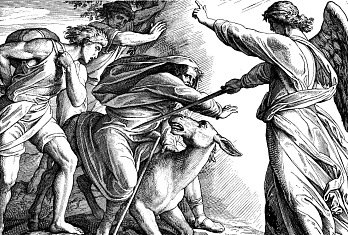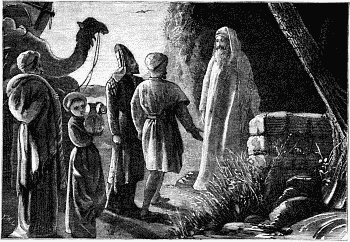Is there any evidence to prove the existence of the prophet, Balaam?
So Balak son of Zippor, who was king of Moab at that time, 5 sent messengers to summon Balaam son of Beor, who was at Pethor, near the Euphrates River, in his native land. Balak said:
“A people has come out of Egypt; they cover the face of the land and have settled next to me. 6 Now come and put a curse on these people, because they are too powerful for me. Perhaps then I will be able to defeat them and drive them out of the land. For I know that whoever you bless is blessed, and whoever you curse is cursed.”
Is there any evidence to prove the existence of the prophet, Balaam?

 | 
In an unprecedented discovery, an ancient text found at Deir Alla, Jordan, in 1967 tells about the activities of a prophetnamed Balaam. Could this be the Balaam of the Old Testament?
The text makes it clear that it is. Three times in the first four lines he is referred to as “Balaam son of Beor,” exactly as in the Bible. This represents the first Old Testament prophet to be dug up in Bible lands—not his tomb or his skeleton, but a text about him. The text also represents the first prophecy of any scope from the ancient West Semitic world to be found outside the Old Testament, and the first extra-Biblical example of a prophet proclaiming doom to his own people.

Balaam with Balak’s messengers
Balaam was not anIsraelite. He was hired by Balak, kingof Moab, to curse the Israelites. They were camped on the east side of the Jordanriver, about to make their historic entry into the promised land. Through God's intervention, Balaam was obliged to bless the Israelites rather than curse them (Num 22-24).
Afterwards, Balaam seems to have been the cause of the Israelites' sin inNumbers 25 when they took Moabite and Midianite women and worshipped the Moabite god Baal-peor (Num 31:16).
Balaam was eventually killed when Moses sent the Israelites against theMidianites (Num 31). He is further condemned in Scripture in 2 Peter 2:15(he loved the wages of unrighteousness), Jude 11 (ungodly men ran greedily after the error of Balaam for reward) and Revelation 2:14 (he taught Balak to cast a stumbling block before the children of Israel, to eatthings sacrificed to idols, and to commit fornication).
The remarkable text found at Deir Alla consists of 119 fragments of plaster inscribed with black and red ink. It was among the rubble of a building destroyed in an earthquake. It seems to have been one long column with at least 50 lines, displayed on a plastered wall. According to the excavators' dating, the disaster was most likely the severe earthquake which occurred in the time of King Uzziah (Azariah) and the prophet Amosin about 760 BC (Amos 1:1; Zec 14:5). The lower part of the text shows signs of wear, indicating that it had been on the wall for some time prior to the earthquake.
Written in Aramaic, the text begins with the title "Warnings from the Book of Balaam the son of Beor. He was a seer of the gods." It is in red ink, as are other portions of the text where emphasis is desired. The reference to the "Book of Balaam" indicates that the text was part of a pre-existing document and therefore the original date of the material is much earlier than the plaster text itself. Balaam goes on to relate a vision concerning impending judgment from the gods, and enters into a dispute with his listeners.
There are a number of similarities between the text and the account ofBalaam in the book of Numbers. To begin with, the events described inNumbers 22-24 took place in the same general area where the text was found. At the time of the Numbers 22-24 incident, the Israelites were camped on the Plains of Moab, across the Jordan river from Jericho. Deir Alla is located about 25 miles north of this area, where the Jabbok river flows into the Jordan valley. Balaam was from Pethor, near "the river" (Num 22:5), in "Aram" (Num 23:7; Dt 23:4).
The reference to Aram has led most scholars to conclude that Balaam was from northern Syria, in the vicinity of the Euphrates river. That does not fit well with the Biblical account, however, since Balaam's home seems to have been close to where the Israelites were camped (Num22:1-22; 31:7-8).
In view of Balaam being revered at Deir Alla, one would expect that Deir Alla was his home. This is exactly what William Shea has proposed, based on his reading of the name Pethor in an inscribed clay tablet found at Deir Alla (1989:108-11). In this case, the river of Numbers 22:5 would be the Jabbok river and the naharaim (two rivers) of Deuteronomy 23:4would be the Jabbok and Jordan rivers.
With regard to the references to Aram, Shea suggests that the original place name was Adam, with the “d” being miscopied as “r,” since the two letters are nearly identical in ancient Hebrew. Adam was a town about eight miles southwest of Deir Alla, on the east bank of the Jordan river, where the Jabbok meets the Jordan.
Balaam evidently was well known as a "cursing prophet," for Balak specifically summoned Balaam for the purpose of cursing Israel (Num 22:6). Much of the Deir Alla text was given to curses uttered by the prophet. The term “shadday-gods” is used on two occasions in the text.Shadday is one of the names for God in the Old Testament, used mainly in the book of Job. Since the account of Job is set in Transjordan (Job 1:1-3), it seems that Shadday was a name used for deity in this region.Balaam used the name twice in his blessing speeches where it is translated “Almighty” (Num 24:4, 16).
The Deir Alla text presents a problem to those who dismiss the Biblical account of the Exodus, Wilderness Wanderings and Conquest as legendary, as is the trend in scholarship today. It is clear that Balaam was a real person who operated on the east side of the Jordan river. He was known as a cursing prophet and continued to be revered hundreds of years after his death. His persona as revealed in the Deir Alla text precisely matches that of the Balaam of Numbers 22-24. If Balaam was a real person, what about Balak, Moses, Joshua and all of the other persons named in the Biblical narrative? They must have been real as well, and the events described authentic.
Recommended for further reading
Related issues
Author: Bryant G. Wood of Associates for Biblical Research
Copyright © 1995, Associates for Biblical Research, All Rights Reserved - except as noted on attached“Usage and Copyright” page that grants ChristianAnswers.Net users generous rights for putting this page to work in their homes, personal witnessing, churches and schools.
www.ChristianAnswers.Net
Christian Answers Network
PO Box 200
Gilbert AZ 85299 Submit your Questions
John R. Salverda comments on this article
....
The character known from the Scriptures as Balaam, almost certainly had a real existence. Evidence for his historicity comes not only from the finds at Deir Alla, but there are other sources that testify to this, rather widely known, seer. In Thrace and Asia Minor he was known as “Priapus.” The Greeks have a “myth” about him arguing with his mule that goes as follows;
Dionysus had a favorite mule who had carried him faithfully throughout his life, however, for some reason the creature had lapsed into madness and was acting crazy. So, Dionysus decided to take him to the oracle at Dodana seeking some advice about a cure. He also took Priapus as a traveling companion. Along the way, no doubt in an attempt to get the cause of the mule's strange behavior from the creature's own point of view, the god granted his donkey the ability to talk. However, Priapus immediately fell into an argument with the mule, apparently over who had the greatest sexual prowess. Well, as the donkey was winning the argument, Priapus became uncontrollably angry and began beating the miserable creature with a stick again and again until the poor animal was dead. (Hyginus, in his "Poetica Astronomica" II, 23; see also his, "Fabulae," 160) Some say that it was this talking mule, who was set by Dionysus amongst the stars as one of the Asseli, in the constellation of the Presipae (the manger), that appears within the Zodiacal sign of Cancer.
Practically every part of this Greek myth has it's counterpart in the Scriptural story of Balaam's ass. As it is Priapus who has an argument with, and beats the talking mule with a stick, it must be he who is to be identified with Balaam, who likewise complains that his ass had "mocked" him. Dionysus is to be identified with Baal-Peor, (the calf god) whom Balaam taught (to which the term “the teaching of Balaam” refers). The reference to sexuality has its’ Scriptural counterpart in the Dionysian licentiousness that was supposed to accompany the rites of Baal-Peor.
Similarly, Priapus was known for attempting to “dishonor” Hestia, the virgin goddess (the Virgin Israel?) and he would have succeeded but for the timely loud braying of the ass he rode in on which woke Hestia up (Ovid Fasti 6.319).
King Midas (from central Asia Minor) had asses ears bestowed upon him by Apollo (Apollo-Pieria?), perhaps because he had harkened unto the teachings of Balaam.
Balaam was so well known in Asia Minor that hundreds of years later in the days of St. John the revelator, and hundreds of miles away in the city of Pergamos (Western Asia Minor), people were still clinging to his teachings (Revelations 2:14).
So much for the people of Thrace an Asia Minor and their version of Balaam, “Priapus.” In Greece proper they had their own version of Balaam, an even more popular character, whom they called “Melampus.” At least three Greek settlements had their own versions of the Balaam story that they had brought with them and transferred to their Greek colonies.
Melampus was a widely known prophet who could understand the speech of animals. In each local version of the Melampus story, the native King would hire him after difficult negotiations (just as in the Scriptural rendition of Balaam‘s tale), to lift a curse. This he would do by teaching the “proper” observance of the rites of Dionysus (the calf god). This is the essence of his story told at Orchomenus, about the daughters of King Minyas, at Argos, about the daughters of King Proetus, and also the story of King “Phylacus.”
Take note of the name “Phylacus” in comparison to the name of King Balak, (Balaam and Balak = Melampus and Phylacus) After an extremely difficult negotiations period, Phylacus hired Melampus to lift a curse of sexual infertility. In this story Melampus understands the speech of animals and injures his foot/leg.
All straight from the Scriptural story of Balaam and from a distant source that actually predates the final editing (by Ezra and Nehemiah) of the Old Testament. Once again the Greek myths, (written, as I believe, by uprooted Israelites) can help to verify the scriptures.
-John R. Salverda
|




Comments